
Lipotidae is a family of river dolphins containing the possibly extinct baiji of China and the fossil genus Parapontoporia from the Late Miocene and Pliocene of the Pacific coast of North America. The genus Prolipotes, which is based on a mandible fragment from Neogene coastal deposits in Guangxi, China, has been classified as an extinct relative of the baiji, but is dubious. The oldest known member of the family is Eolipotes from the Late Miocene of Japan.

Balaenoptera is a genus of rorquals containing eight extant species. Balaenoptera comprises all but two of the extant species in its family ; the genus is currently polyphyletic, with the two aforementioned species being phylogenetically nested within it.
Kentriodon is an extinct genus of toothed whale related to modern-day dolphins. Fossils have been found in North America, Europe and Japan. Several species have been described.
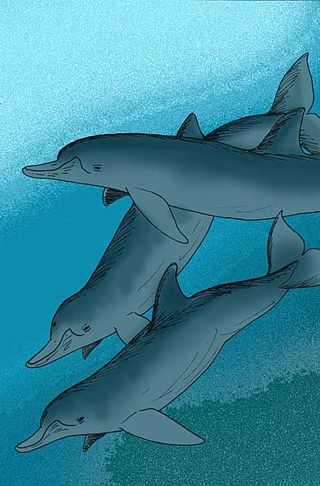
Australodelphis mirus is an extinct Pliocene dolphin. A. mirus is known from fossils found in the Sørsdal Formation, Mule Peninsula, Vestfold Hills, East Antarctica. The genus has been described as an example of convergent evolution with beaked whales.

Kentriodontidae is an extinct family of odontocete whales related to modern dolphins. The Kentriodontidae lived from the Oligocene to the Pliocene before going extinct.

Denebola is an extinct genus of whale belonging to the family Monodontidae. It contains a single known species, Denebola brachycephala. It is the earliest known ancestor of the beluga, Delphinapterus leucas, and dates from the Upper Miocene period. A fossil was found in the Baja California peninsula, indicating that the family once existed in warmer waters.

Orcinus citoniensis is an extinct species of orca identified in the Late Pliocene of Italy and the Early Pleistocene of England. It was smaller than the modern killer whale, 4 m (13 ft) versus 7 to 10 m, and had around 8 more teeth in its jaw. It may have resembled the modern killer whale in appearance, and could represent a transitional species between the modern killer whale and other dolphins. O. citoniensis could have hunted fish and squid in pods, and coexisted with other large predators of the time such as the orcinine Hemisyntrachelus and the extinct shark Otodus megalodon.

Parietobalaena is an extinct genus of baleen whale, belonging to the family Pelocetidae. Fossils are found in Miocene-aged marine strata in North America, Europe, Australia, and Japan, including the Temblor and Itahashi formations. Based on previous estimates of juvenile specimens, Tsai (2017) suggested a body size of 12-15 m for P. yamaokai, akin to that of the gray whale.
Meherrinia is an extinct genus of inioid river dolphin from the Meherrin River, North Carolina, in the United States. First described in 2012, the dolphin is, in most respects, intermediate in form between the living Amazon river dolphin and the La Plata dolphin, although it is probably more closely related to the former. However, the fossil was discovered in what are believed to be marine deposits, dating from the late Miocene, whereas the Amazon river dolphin is an exclusively freshwater species. Meherrinia therefore was, as of 2012, the only known marine genus of the family Iniidae, although others have been discovered since. Only one species is known.
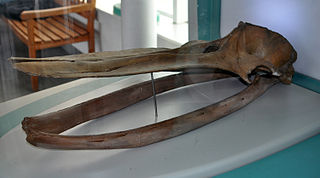
Piscobalaena is an extinct genus of cetaceans, which lived from the Middle to Late Miocene epochs in Peru and Florida. Its fossils have been found in the Pisco Formation of Peru and the Bone Valley Formation of Florida. At least some individuals of this diminutive whale were preyed on by the shark O. megalodon.
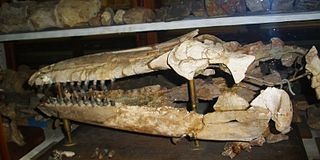
Hemisyntrachelus is an extinct genus of cetacean.

Scaldicetus is an extinct genus of highly predatory macroraptorial sperm whale. Although widely used for a number of extinct physeterids with primitive dental morphology consisting of enameled teeth, Scaldicetus as generally recognized appears to be a wastebasket taxon filled with more-or-less unrelated primitive sperm whales.
Plesiocetus is a genus of extinct rorquals found worldwide. It has had a chequered taxonomic history, having served as a wastebasket genus for a handful of mysticete species.
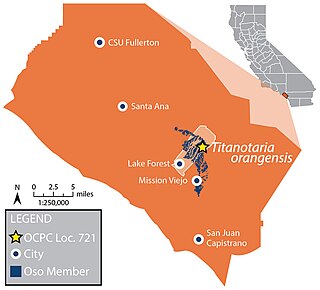
The Capistrano Formation is a geologic formation in coastal southern Orange County, California. It preserves fossils dating back to the late Miocene to early Pliocene, with the Oso Member representing a near-shore environment. Fifty-nine species and varieties of foraminifera are recognized from the Capistrano Formation alongside a diverse array of marine mammals including up to five species of walrus.
The Almejas Formation is a geologic formation in Mexico. It preserves fossils dating back to the Late Miocene to Early Pliocene of the Neogene period.
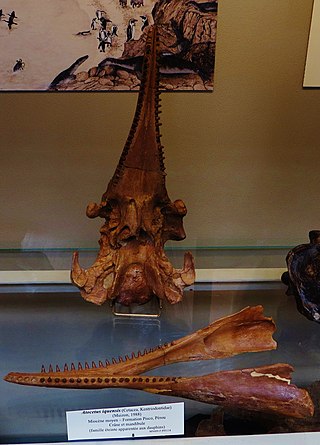
Atocetus is an extinct genus of pontoporiid dolphin found in Miocene-age marine deposits in Peru and California.
Albireonidae is a monotypic group of extinct porpoise-like whales containing the single genus Albireo. These medium-sized, fossil dolphins are very rare and known only from temperate latitudes around the margin of the eastern North Pacific Ocean.

Lophocetus is an extinct genus of dolphin belonging to the clade Delphinida that is known from late Miocene (Tortonian) marine deposits in California and Maryland. Although usually placed in Kentriodontidae, recent studies have found it only distantly related to Kentriodon.
Eolipotes is an extinct genus of marine river dolphin of the family Lipotidae. It is the oldest known member of the family, having lived in what is now Japan during the Tortonian stage of the Late Miocene. Fossils of this animal are known from the Tochigi prefecture and the Gunma prefecture. Eolipotes was a small cetacean, with the skull indicating a length of around 2.17 m. In spite of its name, Eolipoteshas been found to be more closely related to the genus Parapontoporia, which could indicate that some species of Paraprotoporia and the baiji became freshwater animals independently from one another. However it is also possible that they all evolved from ancestors that already inhabited estuaries, with Eolipotes simply becoming more marine. The genus only includes a single species: E. japonicus.














